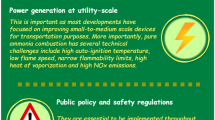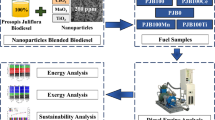Abstract
Urea SCR technology has been widely used to reduce NOx emissions of diesel engines. Despite remarkable development for decades, more advanced control and optimization of urea SCR systems are still required as global NOx emissions standards are expected to become more stringent. This study investigated several influential parameters of urea SCR system to improve NOx reduction efficiency. This study uses a commercialized UWS (Urea Water Solution) supply system and a SCR catalyst which was installed in the exhaust line of a non-road CRDI (Common Rail Direct Injection) diesel engine. From this study, it was found that the low space velocity of SCR catalyst is essential for high NOx reduction efficiency, especially at low temperatures. Early injection of UWS enhances the overall NOx reduction efficiency if UWS injection was carefully controlled to avoid urea deposits. Rich injection of UWS with AOC is a good strategy for high NOx reduction efficiency. However, NOx reproduction in the AOC, which has an adverse effect on the overall NOx reduction rate, occurs at high exhaust gas temperatures. System insulation also can improve the NOx reduction efficiency by a few percentage points.
Similar content being viewed by others
References
Cavataio, G., Girard, J., Patterson, J., Montreuil, C., Cheng, Y. and Lambert, K. C. (2007). Laboratory testing of urea-SCR formulations to meet tier 2 bin 5 emissions. SAE Paper No. 2007-01-1575.
Cho, J., Lee, J., Kim, S., Bang, S., Chun, J. and Kang, J. (2013). A development of urea solution injection quantity decision logic for SCR system. SAE Paper No. 2013-01-1069.
Clark, D. and Pauly, T. (2016). An approach to controlling N2O emission on HDD on-road applications. SAE Int. J. Engines 9, 3, 1626–1629.
Colombo, M., Nova, I. and Tronconi. E. (2010). A comparative study of the NH3-SCR reactions over a Cuzeolite and a Fe-zeolite catalyst. Catalysis Today 151, 3-4, 223–230.
Colombo, M., Nova, I., Tronconi, E., Schmeiser, V., Bandl-Konrad, B. and Zimmermann, L. (2012). NO/ NO2/N2O-NH3 SCR reactions over a commercial Fezeolite catalyst for diesel exhaust aftertreatment: Intrinsic kinetics and monolith converter modeling. Applied Catalysis B: Environmental, 111-112, 106–118.
Drennan, S., Kumar, G., Quan, S. and Wang, M. (2015). Application of automatic meshing to urea-water injection simulation for engine aftertreatment. SAE Paper No. 2015-01-1057.
Girard, J., Cavataio, G. and Lambert, C. (2007b). The influence of ammonia slip catalyst on ammonia, N2O and NOx emissions for diesel engines. SAE Paper No. 2007-01-1572.
Girard, J., Cavataio, G., Snow, R. and Lambert. C. (2008). Combined Fe-Cu SCR systems with optimized ammonia to NOx ratio for diesel NOx control. SAE Int. J. Fuels and Lubricants 1, 1, 603–610.
Girard, J., Snow, R., Cavataio, G. and Lambert, C. (2007a). The influence of ammonia to NOx ratio on SCR performance. SAE Paper No. 2007-01-1581.
Hallstrom, K., Voss, K. and Shah, S. (2013). The formation of N2O on the SCR catalyst in a heavy duty US 2010 emission control system. SAE Paper No. 2013-01-2463.
Han, J., Lee, J., Oh, Y., Cho, G. and Kim, H. (2017). Effect of UWS injection at low exhaust gas temperature on Nox removal efficiency of diesel engine. Int. J. Automotive Technology 18, 6, 951–957.
Hirotaka, N., Yo, T., Taiki, A., Kawamura, S., Daisho, Y., Suzuki, H., Ishii, H. and Yamaguchi, K. (2015). A study on the improvement of NOx reduction efficiency for a urea SCR system. SAE Paper No. 2015-01-2014.
Hou, X., Epling, W., Schmieg, S. and Li, W. (2011). Cu-Zeolite SCR catalyst thermal deactivation studied with FTIR spatial resolution. SAE Paper No. 2011-01-1138.
Hunnekes, E., Heijden, P. and Patchett, J. (2006). Ammonia oxidation catalyst for mobile SCR systems. SAE Paper No. 2006-01-0640.
Jeon, J., Lee, J. and Park, S. (2016). Nitrogen compounds (NO, NO2, N2O, and NH3) in NOx emissions from commercial EURO VI type heavy-duty diesel engines with a urea-selective catalytic reduction system. Energy & Fuels 30, 8, 6628–6634.
Jung, Y., Shin, Y., Pyo, Y., Cho, C., Jang, J. and Kim, G. (2017). NOx and N2O emissions over a urea-SCR system containing both V2O5-WO3/TIO2 and Cu-zeolite catalysts in a diesel engine. Chemical Engineering J. 326, 15, 853–862.
Koebel, M., Madia, G. and Elsener, M. (2002). Selective catalytic reduction of NO and NO2 at low temperatures. Catalysis Today 73, 3-4, 239–247.
Kojima, H., Fischer, M., Haga, H., Ohya, N., Nishi, K., Mito, T. and Fukushi, N. (2015). Next generation all in one close-coupled urea-SCR system. SAE Paper No. 2015-01-0994.
Liu, Z., Wang, H. and Wang, Y. (2012). The model based control strategy for an advanced UREA-SCR system. Proc. FISITA World Automotive Cong., Beijing, China.
Manni, M., Pedicillo, A., Piero, G. and Massara, E. (2007). An experimental evaluation of the impact of lubricating oils and fuels on diesel particulate filters. SAE Paper No. 2007-01-1925.
Matsui, W., Suzuki, T., Ohta, Y., Ito, S., Tanaka, Y., Kikuchi, Y. and Daisho, Y. (2012). A study on N2O formation mechanism and its reduction in a urea SCR systems employed in a DI diesel engine. SAE Paper No. 2012-01-1745.
McKinley, T. and Alleyne, A. (2009). A switched, controlsoriented SCR catalyst model using on-line eigenvalue estimation. SAE Paper No. 2009-01-1284.
Mckinley, T., Alleyne, A. and Lee, C. (2010). Mixture nonuniformity in SCR systems: Modeling and uniformity index requirements for steady-state and transient operation. SAE Int. J. Fuels and Lubricants 3, 1, 486–499.
Murata, Y., Tokui, S., Watanabe, S., Daisho, Y., Suzuki, H. and Ishii, H. (2008). Improvement of NOx reduction rate of urea-SCR system by NH3 adsorption quantity control. SAE Paper No. 2008-01-2498.
Ottinger, N., Schmidt, N. and Liu, Z. (2017). Understanding system- and component-level N2O emissions from a vanadium-based nonroad diesel aftertreatment system. SAE Paper No. 2017-01-0987.
Rajan, V., Mallikarjuna, J. and Venkitachalam, G. (2013). 3-D numerical study of effect of injection parameters upon the uniformity of ammonia in urea-SCR. SAE Paper No. 2013-01-2768.
Rudder, K. (2012). Tier 4 high efficiency SCR for agricultural applications. SAE Int. J. Commercial Vehicles 5, 1, 1639–1649.
Salanta, G., Zheng, G., Kotrba, A., Rampazzo, R. and Bergantim, L. (2010). Optimization of urea SCR system for on-highway truck applications. SAE Paper No. 2010-01-1938.
Sato, S., Sato, S. and Hosoya, M. (2013). Improvement of low-temperature performance of the NOx reduction efficiency on the urea-SCR catalyst. SAE Paper No. 2013-01-1076.
Sharma, P., Venkatachalam, S., Paulraj, P., Halbe, V. and Pandian, S. (2015). An experimental comparison of the uniformity index for two dual stage plate mixers in a SCR system. SAE Paper No. 2015-26-0109.
Sharp, C., Webb, C., Neely, G., Sarlashkar, J., Rengarajan, B. S., Yun, S., Henry, C. and Zavala, B. (2017). Achieving ultra low NOx emissions levels with a 2017 heavy-duty on-highway TC diesel engine and an advanced technology emissions system NOx management strategies. SAE Paper No. 2017-01-0958.
Smith, H., Zochbauer, M. and Lauer, T. (2015). Advanced spray impingement modelling for an improved prediction accuracy of the ammonia homogenisation in SCR systems. SAE Paper No. 2015-01-1054.
Supriyanto, Kurnia, W., Ashor, K., Joshi, S., Kamasamudram, K., Currier, W. N., Yezerets, A. and Olsson, L. (2015). Global kinetic modeling of hydrothermal aging of NH3-SCR over Cu-zeolites. Applied Catalysis B: Environmental, 163, 382–392.
Theis, J. (2009). SCR catalyst systems optimized for lightoff and steady-state performance. SAE Int. J. Fuels and Lubricants 2, 1, 332–341.
Zhan, R., Huang, Y. and Khair, M. (2006). Methodologies to control DPF uncontrolled regenerations. SAE Paper No. 2006-01-1090.
Acknowledgement
This research was supported by the Center for Environmentally Friendly Vehicle (CEFV) as a Global-Top Project of Ministry of Environment, Korea (KMOE) and by the “Development of complex fuel engine technology for high fuel economy” project of the Korea Institute of Machinery and Materials with the support of the Ministry of Science, ICT and Future Planning, Republic of Korea.
Author information
Authors and Affiliations
Corresponding author
Rights and permissions
About this article
Cite this article
Han, J., Kim, T., Jung, H. et al. Improvement of NOX Reduction Rate of Urea SCR System Applied for an Non-Road Diesel Engine. Int.J Automot. Technol. 20, 1153–1160 (2019). https://doi.org/10.1007/s12239-019-0108-6
Received:
Revised:
Accepted:
Published:
Issue Date:
DOI: https://doi.org/10.1007/s12239-019-0108-6




